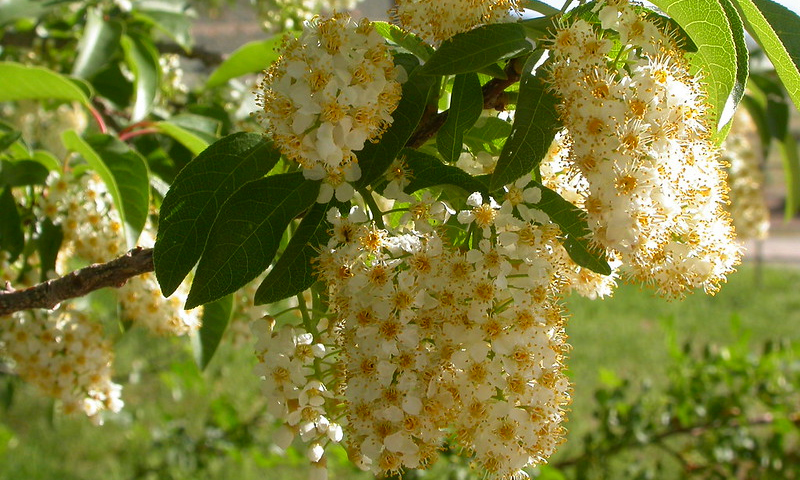
Despite all your diligence and creativity, after a while sheltering in place cannot be sustained. You must get out, go somewhere, anywhere. The walls are closing in. I do not want to burden my adult children with such thoughts, but if you are lucky you may be awakened by a 9 am cellphone call.
“You’ve got ten minutes. Get dressed. We’re going to look for waterfalls.”
My daughter, Katie, and her children live next door. Ten minutes after that phone call, Empress Beatrica Anna, 4, and the Can Man, 1, are buckled in and off we go, babbling and gaping at a springtime world. The nearest falls worthy of the name are Granite Falls east of Everett.

A mere 20 minutes in and the kiddos are fast asleep as we babble on. Then I notice them, bright among dark conifers: the wild cherry trees. I do not remember seeing so many. Unglamorous, wild choke cherry, Prunus virginiana, are bushy little runts rarely more than 30 feet high and living about that many years. Delicate white bloom clusters cover the tree after leaf shoots appear, imparting a pastel green or yellow cast to the display.
Under leaden skies, I remember being frightened by them: part of the claustrophobic press of vernal riot. Unaware of pollen allergies until adulthood, I found spring was for me a time of sickness. But held in hand, the little flowers begged love. As the name “choke” suggests, the little fruits are barely palatable. Unripe red, they make a beautiful dye but constrict the mouth cartoonishly. Ripe black ones suggest sweetness. Some make jam and even wine from them. In bloom, Prunus exudes a menacing vegetal aroma some describe as aphrodisiacal. (A five year-old would not.)
Lummi people chewed the bark to help in childbirth. The Quinault made a tea of it “on somewhat the same principle” in enthnobotanist Erna Gunther’s words, for a laxative. Skokomish and Upper Skagits know it as a cold remedy. They also mixed the rotted toxic wood with water to drink as a contraceptive.
The choke cherry’s beautiful bark is its claim to fame. Native people used strips buffed to a gorgeous copper to imbricate designs on baskets. Tough strands fastened harpoon heads to hafts, barbs to fishing spears, and arrowheads to shafts — pine pitch worked into bindings kept them waterproof and strong,
Suckers branching from a trunk often grow straight as musket barrels. If one is cut so that part of the parent trunk remains below the initial sprouting curve, the whole resembles the elegant stock and barrel of a Kentucky rifle. In the 1950s, when Walt Disney’s Davy Crockett captured young imaginations, we made choke cherry copies of Old Betsy six feet long and buffed to look like well-worn iron. A chrome-plated side vent latch handle from a 1940 Dodge Coupe nailed on properly made the perfect flint lock.
An unexpected treasure from the tree can be found where suckers and limbs fall and decay. As the wood disintegrates, the durable bark remains. Carefully buffed and cut, it makes lovely little coppery finger rings. The dying street person who taught me this called them fairy rings.
The choke cherry’s blossoming phase does not last long. In disturbed land or on road margins, their simple beauty disarms and delights. But make haste. As my daughter said, we have only minutes.

My grandmother Ruby, who lived in a town in northwestern Montana that was basically just a wide spot in the road, made jam from choke cherries. When I was a kid, I hated it but I eventually came to love it. The jam had an astringent quality that reminds me of pomegranates or sumac. I haven’t tasted any since she died in 1990. Thanks for reminding me of this.